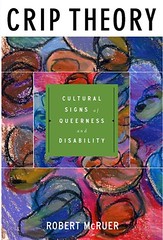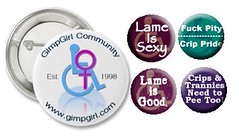 I take six medications. Five of them — the antiepileptic, the antidepressant, the non-narcotic pain killer, the muscle relaxer, and the oral contraceptive — are covered through a mail-order service. I receive a 90-day supply in my mail box every three months. No hassle. If a prescription runs out, my doctor is notified electronically, he then sends the new script electronically, and everything proceeds as normal with absolutely no additional step required of me. The only thing I do is click on the check-out button on the web site every three months. That’s it. No calling. No physical piece of paper to pick up. No wait at a retail pharmacy. Just a click and several days’ wait.
I take six medications. Five of them — the antiepileptic, the antidepressant, the non-narcotic pain killer, the muscle relaxer, and the oral contraceptive — are covered through a mail-order service. I receive a 90-day supply in my mail box every three months. No hassle. If a prescription runs out, my doctor is notified electronically, he then sends the new script electronically, and everything proceeds as normal with absolutely no additional step required of me. The only thing I do is click on the check-out button on the web site every three months. That’s it. No calling. No physical piece of paper to pick up. No wait at a retail pharmacy. Just a click and several days’ wait.
There’s one other medication I take. That medication serves the exact same purpose as all five others: it relieves my pain so that I can get on with my daily functions. I take it regularly, just like all five others. I have been taking it regularly for over five years now for the same reason. But this medication is not covered by the mail order service, because it is not considered a “maintenance medication” — despite that it fills the exact same maintenance role all five others fill, just by a different mechanism.
So for this medication, I am only allowed a 30-day supply at a time, and no refills — a brand new script each fill, which requires my doctor’s input each time. I have to call my doctor no sooner than the exact day it was filled last month, unless it falls on a weekend in which case I might get away with calling up to 2 days early. Then I have to call back a couple days later to see if the script has been written. If it has, it is printed out, and I have to physically walk in to the office, stand in line to see a receptionist, have them take a copy of the script with my photo ID, sign and date the copy, and walk out with the script. Then I have to physically take it into a retail pharmacy, wait in line, hand it to the pharmacy technician, then wait the required time for it to be filled. If there are no problems with my insurance, I then must physically present myself and pay for the prescription. Then I can walk out the door with my medication.
(And this is the process with a doctor who’s relatively friendly about the matter.)
It is quite a different process and one overflowing with “veto points” — points at which any party involved can cause any sort of problem and stop the whole process up. Maybe my doctor is on vacation and won’t be back for two weeks. He is the only one in my clinic who will write this script. I can’t call earlier in anticipation of his absence; they will not write the script before the last runs out. In that case, I’m stuck until he comes back. Maybe the system spits out some sort of error, like the one I received today: I was told the script must be written by my original prescriber. Which is this doctor. So now they have to go back and ask for the script all over again, and he isn’t in til tomorrow, and it’s not guaranteed to go through smoothly then. There have been other errors.
Maybe the insurance says no. For any number of reasons; I’ve dealt with prior authorization errors, quantity limit errors, errors because my insurance has suddenly decided to list me as living in an assisted-living home and cannot fill a prescription if I am. Maybe the pharmacy hits a snag, like the time they would not fill a written prescription until 2 a.m. that night because the insurance company said so, even if we paid out of pocket without billing the insurance.
And I’m going to keep running into these issues, and I will run into new errors every few months. I may have solved the last problem, but there’s always something new to pop up. I can never rely on this medication being filled on-time. It simply does not happen the majority of the time. No matter how diligent I am, how patient I am, how clearly and politely I explain myself — or how despondent I get, how emotional I get when telling them but I cannot work without this medication, and I don’t have leave on this job, and I can’t afford to be fired for missing work. Or whatever other pickle I’m in at the moment. It doesn’t matter. I do everything right and there will still be regular problems in getting my medication filled on time.
I’m sure, by now, you’ve figured out that this particular medication is a narcotic pain killer — hydrocodone (generic for Vicodin). I take it for chronic pain. I have been taking it for over five years this way, with the doses varying between one-and-a-half per day and three per day. And the only medical trouble I have ever had on it is when there was an excessive delay in refill during a bad pain flare and I got to go through the withdrawal for two weeks. (And I can tell you from experience: hydrocodone withdrawal is nothing compared to Effexor withdrawal.)
Narcotic pain killers can be a valid option for chronic pain patients. They fill a void left by other treatments which still aren’t effective enough to address our symptoms, which can easily be disabling. As you can see, I take plenty of other medications. But if I want to be able to get up and do something, I still need the pain relief the hydrocodone provides. So I take it. Because I like to be able to get up and do things. Like make the bed in the morning and feed the cats and make myself lunch and possibly run errands. Or — you know — work. Those silly sorts of things.
Here’s the thing, though. In both common culture and the medical industry, chronic pain patients who take these medications to be able to perform everyday, ordinary tasks that currently-able people take for granted — like bathing or showering or washing dishes or dropping their kids off at school — are still constructed as an addict just looking to get high.
You could almost kind of expect that for the narcotics. Most people do not understand the distinction between addiction and dependence. (Which is, basically, the distinction between taking a medication for a medical purpose so that you can go on living your everyday life, vs. taking a medication when you have no medical need so that you can escape from your everyday life.) This distinction exists for a reason; developing a tolerance for a medication is not a bad thing in and of itself, and must be weighed against the benefits that medications brings to the person.
Addiction calls to mind, though, a life being torn down. Addiction calls to mind a person who is seeing the detriment of a drug outweighing the benefit. A person whose life is falling apart because of the drug.
A chronic pain patient taking a narcotic pain killer under the close supervision and guidance of a knowledgeable doctor is exactly the opposite: sie is a person whose life is coming back together because of the drug.
But this image is not easily shaken in people’s minds. And so the chronic pain patient is reimagined as the addict. Hir behaviors are twisted to fit the common conception of the addict. If sie ever lets out a drop of disappointment at having problems with accessing this medication which is helping to put hir life back together — that is seen as drug-seeking behavior. And if sie lets out any sort of relief at the feeling sie experiences after taking the pill and having the crushing weight lifted from hir muscles — that is seen as “getting a high.” Heaven forbid sie show any emotion beyond just relief — like perhaps pleasure or happiness — at being able to perform everyday functions again. And any moodiness or other undesirable behavior can be easily attributed to hir “addiction.”
What’s strange, I notice, is that this reimagining is applied not only to chronic pain patients who take narcotics — but to any chronic pain patients who takes any pain relieving drug.
Take, for example, the anti-epileptic I take. It is not a narcotic. It cannot be abused — that is, if you do not have a neurological pain disorder, it will not do anything for you. You can’t use it to get high, get low, or get anything — except a couple hundred dollars poorer every month.
The only way this pill does anything for you is if you have some sort of nerve problem. And even then, the effect isn’t a “high.” Rather, it levels your pain threshhold — brings it closer to “normal.” No artificial mood effects, no giddiness, no lift. Just level.
And I still see this medication treated very similarly. Patients who take it are described in the same terms you would describe a drug addict.
And it’s just one of many. Any drug that relieves pain for a person with chronic pain will be painted in the same strokes.
At issue, here, is the conventional wisdom that our pain is imagined, that it has no real basis, or even then that it isn’t as bad as we make it out to be. That is the belief that feeds this twisted construction.
Because if you are imagining your pain, there is nothing legitimate you could be getting out of that drug. And if you aren’t getting anything legitimate out of it, but you’re still taking it — and getting upset when you don’t have it — well, that’s classic addict behavior, isn’t it?
If our pain were recognized as real and legitimate — if those messed-up-in-so-many-ways Lyrica commercials didn’t start out with “My fibromyalgia pain is real!” — this wouldn’t happen as much. Because if our pain is real and legitimate, then it is real and legitimate to seek relief for it.
(Of course, that assumes that pharmaceuticals are accepted as a real and legitimate way to relieve that pain.)
But people are going to have trouble with that. They don’t want to accept our pain. They don’t want to admit that it is real. They want to keep believing that it must be imagined. Because then, they can comfort themselves, in that murky area beneath our conscious thought, that they would never end up in our situation. They could never end up with any sort of medical condition. And if they did, well, they know how to do everything right, so they would never be affected by it.
This is why they scoff at our assertions that our experiences are real. This is why our conditions are jokes to a great many people. This is why “fibromyalgia is bullshit” has been the leading search term to my blog. This is why they seek so desperately to deny that these drugs — any drug — could be having a legitimate effect on us. This is why they treat us like addicts. Because they can see how we might reasonably be having real pain, and they can see how these drugs might reasonably be legitimately relieving it, and they can see how we might reasonably be upset if we are consistently denied access to the one thing that allows us to live our lives the way we want to.
And if all that is reasonable, then — shit — they could wind up in the same place someday. And none of their can-do bootstrap individual determination could magically get them out of it.
Addicts we are, then.




 I take six medications. Five of them — the antiepileptic, the antidepressant, the non-narcotic pain killer, the muscle relaxer, and the oral contraceptive — are covered through a mail-order service. I receive a 90-day supply in my mail box every three months. No hassle. If a prescription runs out, my doctor is notified electronically, he then sends the new script electronically, and everything proceeds as normal with absolutely no additional step required of me. The only thing I do is click on the check-out button on the web site every three months. That’s it. No calling. No physical piece of paper to pick up. No wait at a retail pharmacy. Just a click and several days’ wait.
I take six medications. Five of them — the antiepileptic, the antidepressant, the non-narcotic pain killer, the muscle relaxer, and the oral contraceptive — are covered through a mail-order service. I receive a 90-day supply in my mail box every three months. No hassle. If a prescription runs out, my doctor is notified electronically, he then sends the new script electronically, and everything proceeds as normal with absolutely no additional step required of me. The only thing I do is click on the check-out button on the web site every three months. That’s it. No calling. No physical piece of paper to pick up. No wait at a retail pharmacy. Just a click and several days’ wait.